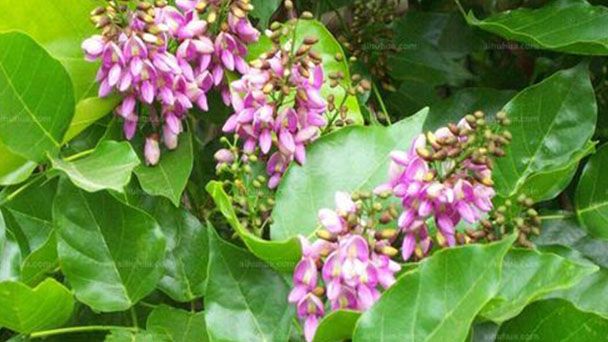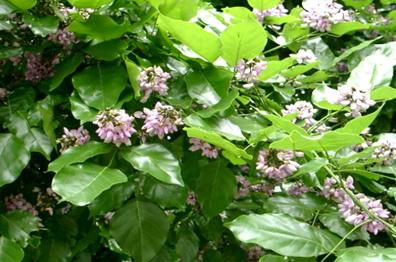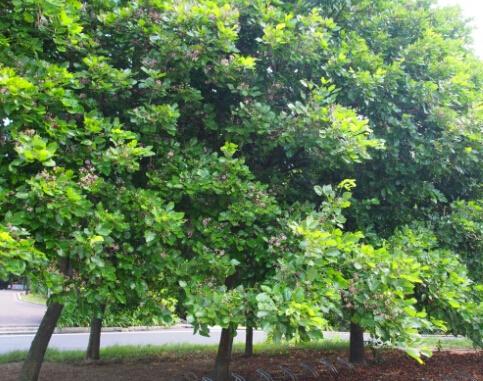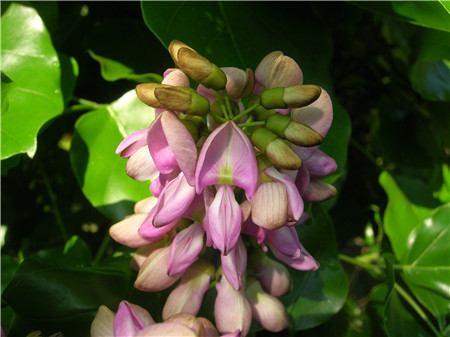Pongamia pinnata profile
Written by Maggie
Mar 25 2021

Pongamia pinnata, also known as Pongam, Karum tree, poonga-oil tree, is a medium-sized fast-growing tree, the only plant in the genus Pongamia in the leguminous family. Pongamia pinnata is a semi-mangrove plant widely distributed in the Pacific coastal areas from Southeast Asia to northern Australia. It is also widely distributed in Guangdong, Hainan and Taiwan in China.
Pongamia Pinnata picture

Morphological characteristics of Pongamia Pinnata
Branch
Pongamia Pinnata is an arbor, 8-15 meters high. Twigs are usually glabrous, sometimes slightly pilose, old twigs densely with gray-white lenticels.
Leaf
Pongamia Pinnata has pinnately compound leaves 20-25 cm long; Leaflets are 2-3 pairs, subleathery, ovate, broadly elliptic to oblong, 5 -- 10 cm long, 4 -- 8 cm wide, apex short acuminate or rounded, base broadly cuneate, rounded or sub truncate; Petiole is 6-8 mm long.
Flowers
Pongamia pinnata is an axillary raceme, 15 -- 20 cm long, usually in clusters of 2 flowers on nodes of the main axis; Pedicels are 5 -- 8 mm long, with 2 ovate bracteoles under calyx; Calyx ca. is 3 mm, calyx teeth inconspicuous, outside slightly rust-colored pubescent, margin especially dense; Corolla is white to pink, 12-14 mm long, stipitate. Flag valve is abaxially silky, margin incurls, keel valve slightly curved.
Fruit
The pod of pongamia pinnata is 4-5 cm long and 1.5-2.5 cm wide, with an inconspicuous verruca on the surface, a short beak slightly curved at the tip, no dehiscence, no raised edges or wings along the suture lines, and 1 seed; Seeds are reniform.
Ecological habits of Pongamia Pinnata
Pongamia Pinnata likes high temperature, humid and sunny or semi-cloudy environments, both full and half sunshine are ideal; The sandy loam rich in organic matter is the best cultivation soil. Pongamia pinnata has strong germination, salt resistance, strong wind resistance, drought resistance, cold resistance, negative resistance are good, and can resist air pollution.
Pongamia Pinnata is born near streams, ponds and tidal energy.
Propagation of Pongamia Pinnata
The conventional method of propagation of Pongamia pinnata is mainly seeding and cutting.
Seed propagation
Pongamia pinnata sowing propagation is first of all to the seed selection, it is best to choose the seeds harvested in those days. As the seed is kept longer, its germination rate will decrease. The selection of seeds should be full, without imperfection or deformity, and there are no pests and diseases. Before sowing, the seeds should be disinfected. The common method is to soak seeds in hot water at about 60 ℃ for 15 minutes. Then use warm water to accelerate germination for 12 ~ 24 hours. The seeds are sown in disinfected substrate, covering the substrate with about 2 ~ 3 times the thickness of the seed. Transplant most seedlings when they have three or more leaves.
Cutting propagation
Pongamia Pinnata can be propagated by cuttings of current year's twigs in late spring and early autumn, or by cuttings of old year's twigs in early spring, usually only one generation can be propagated in a year. Cuttage uses nutrient soil or the material such as soil of river sand, mud carbon commonly, the river sand of sea sand and salinization area does not use. At the end of spring to early autumn when the plant is growing exuberant, choose that year to grow stout branches as cuttings, a section of 5 ~ 15 centimeters long, each section should take 3 or more than 3 leaf buds. The optimal rooting temperature of cuttings is 20 ℃ ~ 30 ℃, and the appropriate relative humidity of air is 75 ~ 85%. A certain shade should be carried out on sunny days, and cuttings should be sprayed 3-5 times a day. Transplant when the seedlings are about 10 centimeters long. Pongamia pinnata is a tropical plant that has a strict winter temperature requirement, cannot overwinter naturally in areas with frost, and must also be watered moderately during the winter.

Pongamia Pinnata care
After flowering, it is advisable to prune the branches of Pongamia Pinnata, arrange the crown of the tree, and prune once a year in early spring. Fertility temperature of 22 to 32 degrees Celsius, transplantation time is appropriate all year round.
The distribution of Pongamia Pinnata
Pongamia Pinnata is found in Fujian, Guangdong (southeastern coastal areas), and Hainan.
Pongamia Pinnata is also found in India, Sri Lanka, Malaysia, Australia, and Polynesia.
Pongamia pinnata uses
Medical uses
Pongamia Pinnata whole plant can be used as emetic and pesticide.
Garden use of Pongamia Pinnata
Pongamia Pinnata can be used as a bank protection forest and street tree in coastal areas.
Economic value
The dense and beautiful wood of Pongamia Pinnata can be used to make all kinds of appliances.
The seed oil of Pongamia Pinnata is used as fuel.

Latest Updated
- Benefits of Bugleweed - 7 Science-backed Health Benefits
- Bugleweed Dangers & Side Effects - Is It Poisonous?
- How to Plant Evergreen Trees - What You Should Know
- When to Plant Evergreens - Grow Guide for Evergreen Trees
- 12 Wonderful Evergreen Shrubs for Your Garden
- 12 Popular Evergreen Plants with Pictures for Beginners
- When And How To Prune A Lilac Bush Like a Pro
- How to Grow & Care for Lilac Vine (Hardenbergia Violacea)
- Japanese Lilac Tree (Syringa Reticulata) Care & Propagation Guide
- Shumard Oak Pros and Cons - What to Know
Popular Articles
- Winter maintenance of Antirrhinum Majus
- How to Grow Terminalia Mantaly Tree
- How to Grow and Care for Crossostephium Chinense
- How to grow Antirrhinum Majus in spring
- Peristeria Elata (Dove Orchid) Profile: Info & Care Guide
- Underwatered Snake Plant (Sansevieria Trifasciata) - Signs And How To Fix
- How to Care for Brazilian Jasmine Plant (Mandevilla Sanderi)
- How to Grow & Care for Graptopetalum Purple Delight in Summer
- Rosa Chinensis (China Rose): Plant Growing & Care Tips
- How to Care for Baby Sun Rose (Aptenia Cordifolia)